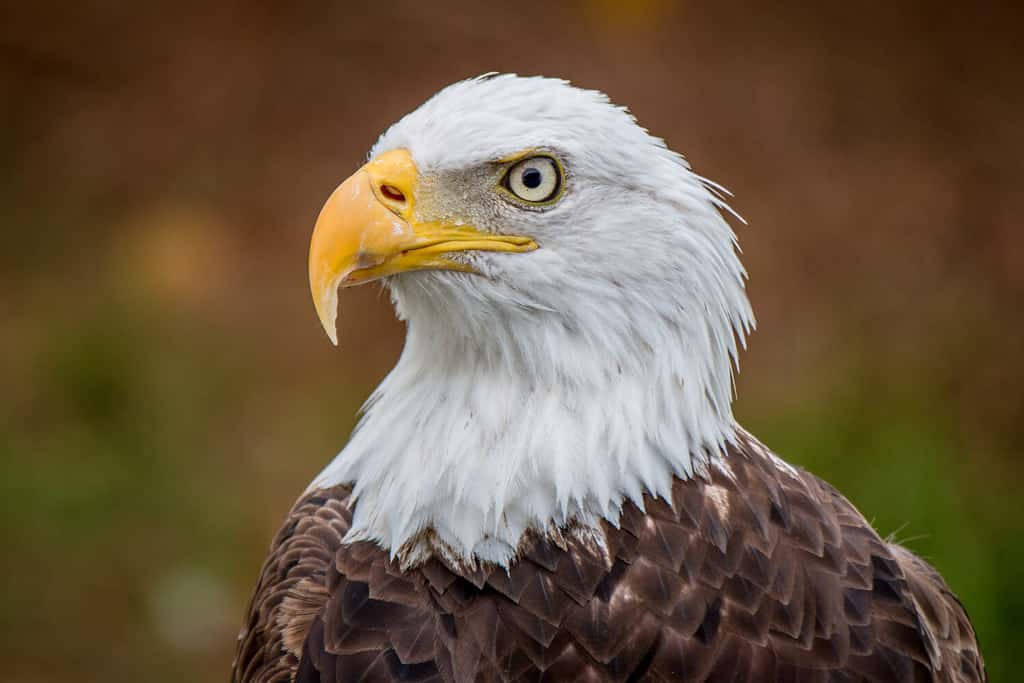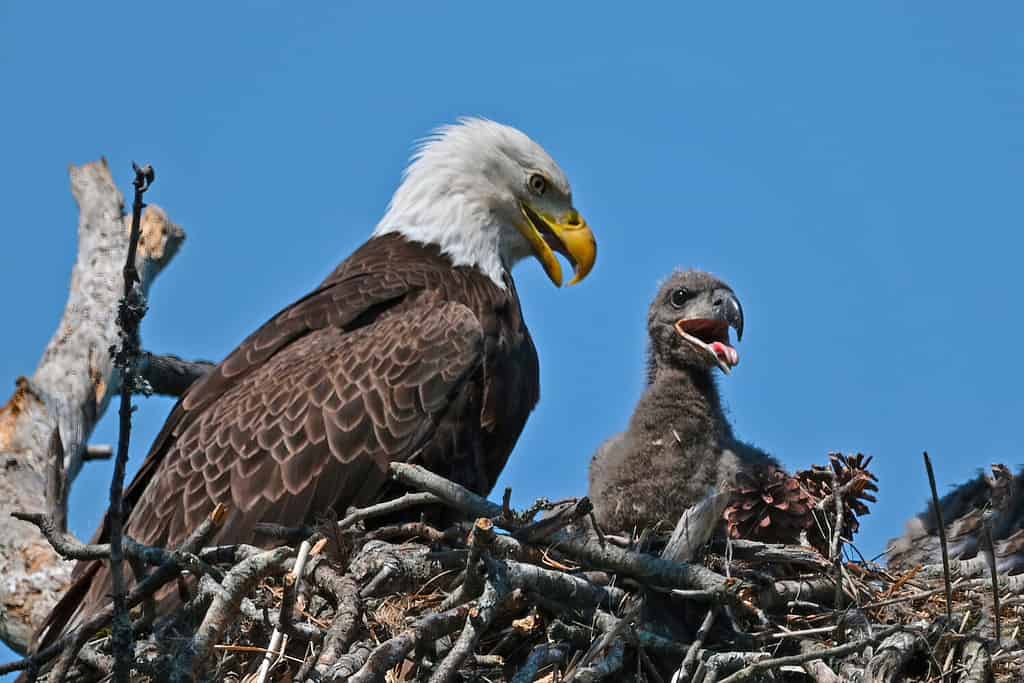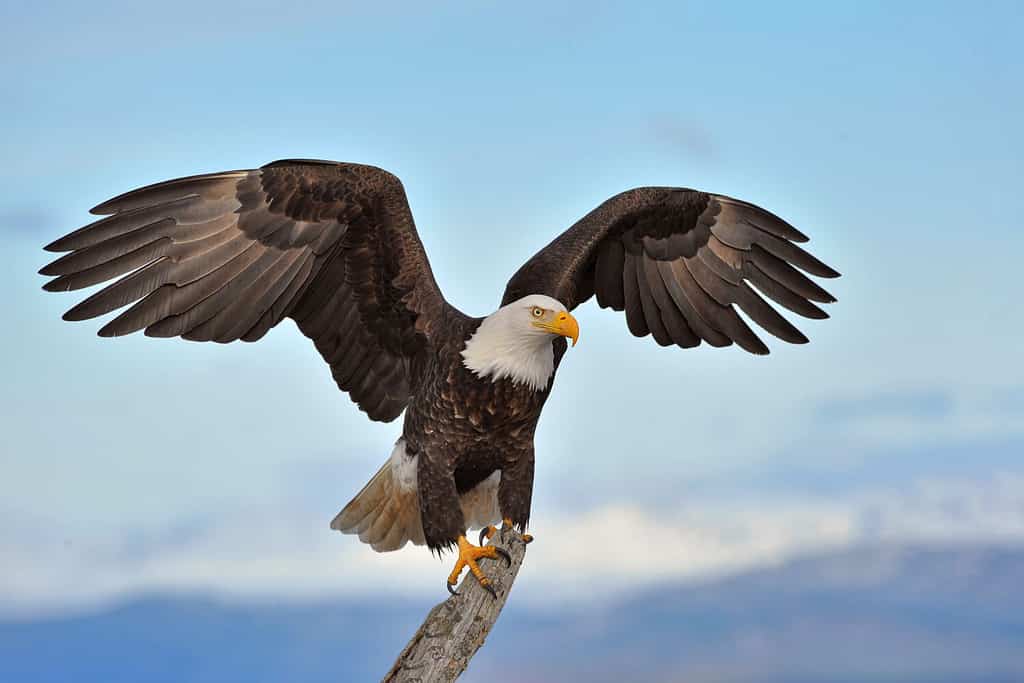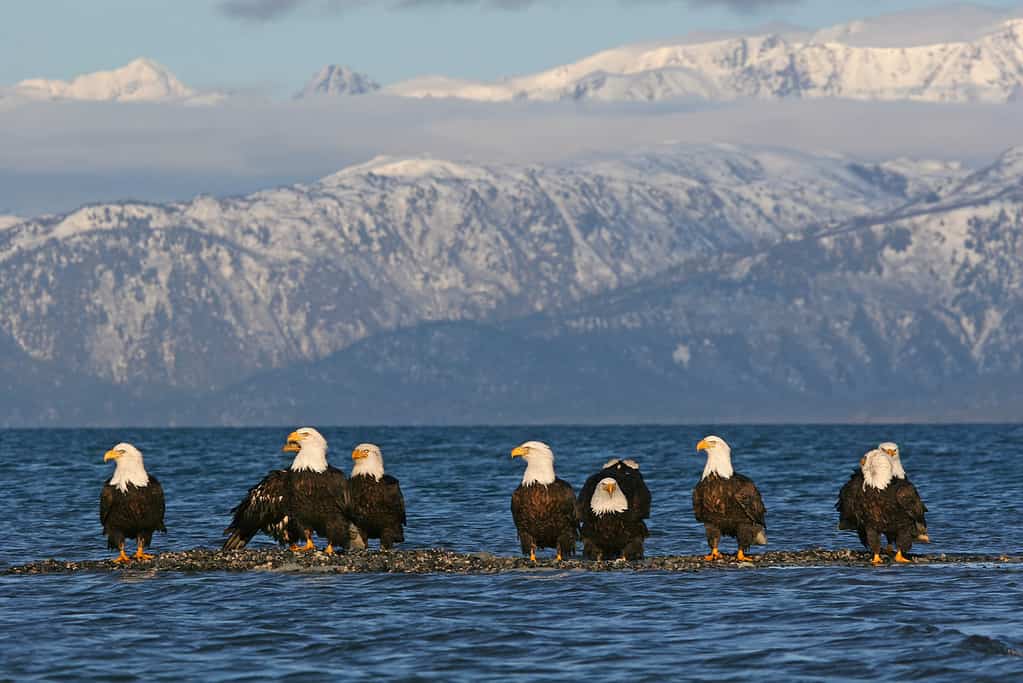Do you want to know when and where to see bald eagles in Washington?
Washington State is a treasure trove for bald eagle enthusiasts. If you’re eager to witness these majestic birds in their natural habitat, you’ve come to the right place.
In this comprehensive guide, we’ll talk about bald eagle’s habitat and what they like to eat. We’ll include some tips on finding and watching these majestic creatures. And finally, we’ll reveal the best places and times to see bald eagles in Washington.
So, start planning your trip for a remarkable experience.
Bald Eagles: Their Habitat, Diet, and Special Characteristics
Bald eagles (Haliaeetus leucocephalus) are large and iconic birds of prey known for their striking appearance and significant cultural symbolism. Here’s some information about them:
Habitat
- Range: Bald eagles are primarily found in North America, with their range extending from Alaska and Canada down to the contiguous United States, Mexico, and even parts of northern Central America.
- Habitat: They inhabit a variety of ecosystems, but they are most commonly associated with aquatic environments. They prefer areas near large bodies of water, such as lakes, rivers, estuaries, and coastal shorelines. These habitats provide them with an abundant source of their primary food, fish.
What They Eat
- Fish: Fish make up the majority of their diet, and they are skilled hunters, swooping down from perches or soaring in the sky to catch fish from the water’s surface.
- Waterfowl: Bald eagles also prey on waterfowl, especially during the winter when fish may be less available. They may hunt ducks, geese, and other waterfowl.
- Carrion: They are opportunistic scavengers and will often feed on carrion (dead animals) they find, including roadkill or fish that have died naturally.
- Small Mammals: On occasion, they may catch small mammals like rabbits or squirrels.

The bald eagle has a distinctive white head.
©Kevin Tubbergen/Shutterstock.com
Special Characteristics
- White Head and Tail: Adult bald eagles are easily recognized by their distinctive white head and tail feathers. Juvenile eagles do not develop this iconic coloration until they reach maturity at around 4-5 years of age.
- Powerful Beak and Talons: They have strong, hooked beaks and sharp talons that enable them to catch and carry prey.
- Large Size: Bald eagles are one of the largest raptors in North America, with wingspans that can reach up to 7 feet (2.1 meters) and body lengths of up to 3 feet (0.9 meters).
- Symbol of the United States: The bald eagle is the national bird and symbol of the United States. It is featured on the country’s Great Seal and various national emblems, representing freedom, strength, and patriotism.
- Bald eagles suffered population declines due to hunting, habitat loss, and DDT in the mid-1900s. However, thanks to conservation efforts, including the banning of DDT and legal protection, their numbers have rebounded, and they were removed from the U.S. Endangered Species List in 2007.
- Migratory Behavior: While some bald eagles are year-round residents in their territories, others are migratory. They may travel long distances between their breeding and wintering grounds.
Bald eagles are not only ecologically important as top predators in their ecosystems but also hold immense cultural significance in North America. They are a symbol of natural beauty and the importance of conservation to save their populations and habitats.
Tips for Seeing Bald Eagles
Watching and finding bald eagles can be an exciting and rewarding experience. These majestic birds are often associated with North America and are known for their impressive hunting skills and iconic appearance. Here are some tips to help you spot and enjoy bald eagles in the wild:
Research Their Habitat
- Bald eagles are typically found near bodies of water, such as lakes, rivers, coastlines, and marshes. They prefer areas with abundant fish as their primary food source.
- Learn about local bald eagle nesting sites and roosting areas, as they tend to return to the same locations year after year.
Choose the Right Season
- Bald eagles are more active and easier to spot during the winter months (November to February) when they congregate near open water to hunt for fish and waterfowl.
- Nesting season (spring to early summer) is another good time to observe them as they care for their young.
Use Binoculars or a Spotting Scope
- Bald eagles can be seen soaring at great heights, so binoculars or a spotting scope are essential tools for close-up viewing.
- Look for their distinctive white head and tail feathers against the backdrop of the sky or trees.
Visit Eagle Hotspots
- Check local birdwatching websites, nature centers, or wildlife refuges for information on where bald eagles are commonly sighted in your region.
- Some national and state parks are known for their eagle populations, making them ideal destinations for eagle watching.
Go Early and Be Patient
- Eagles are often most active during the early morning and late afternoon, so plan your outings accordingly.
- Be prepared to spend time waiting and observing, as eagles may not always be immediately visible.
Look for Nesting Sites

Bald eagles build large nests in tall trees near water.
©Brian E Kushner/Shutterstock.com
- Bald eagles build large nests in tall trees near water. Look for these massive stick nests, known as aeries, in their favored nesting areas.
- Observe from a distance and avoid disturbing nesting eagles, as they can become stressed and abandon their nests if they feel threatened.
Watch for Behavior
- Keep an eye out for eagles fishing, perching, or flying in a circular pattern, which they often do while hunting.
- They may also engage in aerial displays during courtship or territorial disputes.
Join a Birdwatching Group
- Birdwatching clubs and organizations often organize field trips and events for eagle watching. Joining such a group can be a great way to learn from experienced birdwatchers.
Be Respectful and Ethical
- Maintain a safe distance and use quiet observation techniques to avoid disturbing the birds.
- Follow ethical birdwatching guidelines, such as not approaching nests, not feeding the birds, and leaving no trace.
Keep Records
- Consider keeping a birdwatching journal or using a birding app to record your eagle sightings. This can help you track their behavior and movements over time.
Remember that bald eagles are protected by federal laws in the United States, so it’s crucial to observe them responsibly and legally. Enjoy your eagle watching adventure and the beauty of these remarkable birds in their natural habitat.
Where to See Bald Eagles in Washington

Bald eagles are large and iconic birds of prey known for their striking appearance and significant cultural symbolism.
©FloridaStock/Shutterstock.com
1. Skagit River Valley
When: November to February
What makes it special: During the winter months, the Skagit River Valley transforms into a bald eagle hotspot. Thousands of eagles gather here to feast on the chum salmon runs. Prime viewing spots include Rockport State Park and the Skagit Wildlife Area.
2. Lake Coeur d’Alene, Idaho (Near Washington Border)
When: December to February
What makes it special: While not in Washington, Lake Coeur d’Alene, just across the border in Idaho, offers excellent eagle viewing opportunities during the winter months. Eagles are drawn to the lake’s open water, where they hunt for fish.
3. Lake Sammamish State Park
When: December to February
What makes it special: Located just east of Seattle, Lake Sammamish State Park is a hidden gem for eagle sightings. The lake offers ample fish, attracting eagles during the winter. Don’t forget your binoculars!
4. Nisqually National Wildlife Refuge
When: Year-round, with peak sightings in winter
What makes it special: Nisqually National Wildlife Refuge, near Olympia, is a year-round bald eagle haven. You can spot eagles here throughout the year, but winter brings an influx of migratory eagles.
5. Lake Chelan
When: December to March
What makes it special: Nestled in the Cascade Mountains, Lake Chelan is another winter eagle-watching spot. The lake’s open water and salmon runs are irresistible to eagles.
6. Columbia River Gorge
When: Year-round, with peak sightings in winter
What makes it special: The Columbia River Gorge, especially around the Bonneville Dam, is a hotspot for bald eagles. Witness eagles fishing near the dam year-round, with the best chances in the winter.
7. Conconully Reservoir
When: December to February
What makes it special: In north-central Washington, the Conconully Reservoir is a winter playground for bald eagles. The nearby town of Conconully hosts an annual eagle-watching festival.
8. San Juan Islands
When: Year-round, with peak sightings in winter
What makes it special: The San Juan Islands are a year-round eagle habitat. The islands’ diverse ecosystems make them attractive to eagles, and you can often spot them perched in trees or soaring overhead.
9. Lake Wenatchee State Park
When: December to February
What makes it special: Located in the Wenatchee National Forest, this park becomes an eagle magnet in the winter. The combination of open water and spawning salmon draws bald eagles in large numbers.
10. Lake Roosevelt National Recreation Area
When: Year-round, with peak sightings in winter
What makes it special: The Lake Roosevelt National Recreation Area along the Columbia River offers a chance to see eagles throughout the year. Visit in winter for the best eagle-watching experience.
11. The Dalles, Oregon (Near Washington Border)

Bald eagles prefer areas near large bodies of water, such as lakes, rivers, estuaries, and coastal shorelines.
©iStock.com/Silfox
When: Year-round, with peak sightings in winter
What makes it special: Just across the Columbia River from Washington, The Dalles in Oregon is a great spot to witness eagles. Look for eagles near The Dalles Dam, where they gather to feed.
12. Potholes Reservoir
When: December to February
What makes it special: Located in central Washington, Potholes Reservoir is a winter haven for bald eagles. The combination of open water and abundant fish make it a popular spot.
13. Puget Sound
When: Year-round, with peak sightings in winter
What makes it special: The Puget Sound region is home to a variety of habitats that attract eagles year-round. In the winter, look for them near river mouths and estuaries.
14. Lake Roosevelt and Grand Coulee Dam
When: Year-round, with peak sightings in winter
What makes it special: The combination of the massive Lake Roosevelt and Grand Coulee Dam creates an ideal environment for eagles. Visit during the winter to see eagles in abundance.
15. Boundary Bay, British Columbia (Near Washington Border)
When: November to February
What makes it special: While not in Washington, Boundary Bay in British Columbia, just north of the U.S.-Canada border, is a renowned winter destination for bald eagles. Thousands gather to feast on spawning salmon.
16. Mount Rainier National Park
When: Year-round, with peak sightings in winter
What makes it special: Mount Rainier National Park is not just about stunning landscapes; it’s also home to eagles year-round. Winter offers a unique opportunity to see these birds against a backdrop of snow-capped peaks.
17. Ocean Shores
When: November to March
What makes it special: The coastal town of Ocean Shores becomes an eagle-watching hub during the winter. The eagles are drawn to the area’s abundant marine life.
18. Lake Washington Ship Canal, Seattle
When: December to February
What makes it special: Seattle’s Lake Washington Ship Canal, which connects Lake Washington to Puget Sound, is a surprising eagle hotspot. The canal’s waters attract eagles during the winter months.
19. Grays Harbor National Wildlife Refuge
When: November to February
What makes it special: Grays Harbor National Wildlife Refuge, located along the Washington coast, is a winter retreat for eagles. Watch them hunting in the refuge’s tidal flats and estuaries.
20. Hoh Rainforest, Olympic National Park
When: Year-round, with peak sightings in winter
What makes it special: While bald eagles are a year-round presence in Olympic National Park, the winter months provide a unique opportunity to see them in the lush Hoh Rainforest.
Washington State has many chances to see bald eagles in their natural homes. You’ll have an unforgettable experience whether you’re exploring the Skagit River Valley during winter salmon runs or watching eagles fly over the San Juan Islands.
Plan your visit according to the season and location as eagle-watching conditions can change. Remember to bring binoculars, camera, and patience to see bald eagles in Washington..
So, pack your gear, choose your spot, and get ready to witness the grace and grandeur of America’s national bird in the beautiful state of Washington.
The photo featured at the top of this post is © FloridaStock/Shutterstock.com
Thank you for reading! Have some feedback for us? Contact the AZ Animals editorial team.







